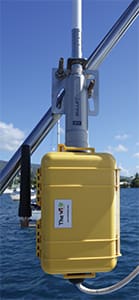Starting in the mid-2000s, sailors and power voyagers could install a relatively simple Wi-Fi system on their vessels to capture free Internet up to a mile away. Cruisers could anchor offshore and still find service from coastal cafes, marinas and even homes.
With few exceptions though, those days are long gone. Most home and business routers now require a password to connect. The popularity of wireless Internet has led to interference that diminishes the ability to receive a signal over longer distances, according to Dalton Williams, owner of the company Wi-Fi for Boats.
It’s gotten to the point where Williams often uses cellular data aboard his 41-foot DeFever Easy Living, where he lives year-round, rather than Wi-Fi.
“I have basically talked people out of buying my system now because I think they will be disappointed,” Williams said in a recent phone interview.
Although it’s rare to find an unlocked wireless router these days, new technologies have made Wi-Fi available in millions of places across the U.S. Cable companies such as Time Warner, Comcast’s Xfinity Internet and Bright House Networks have created broad networks of hot spots offering download speeds that rival land-based connections.
These hot spots are open to existing cable Internet subscribers and in many instances non-subscribers as well. Current customers can log on for free, although non-users can pay for access in increments ranging from an hour to a month depending on the company. Time Warner and Xfinity, for instance, both offer “Access Pass” connections to non-subscribers.
Logging on is fairly simple, but users must first download an app from the cable operator’s website or Apple or Google app stores. From there, users establish a profile that allows for seamless transition between hot spots in different locations, according to Charlie Douglas, an Xfinity Wi-Fi spokesman.
Coverage maps and other details are available on providers’ websites.
Data download speeds on Xfinity’s hot spot network reach 25 mbps, which is plenty fast for casual browsing and checking email and weather. It also offers more than enough bandwidth to stream Netflix, Hulu or Amazon Prime, Douglas said.
These hot spots are powered by the wireless routers installed in homes and businesses. The routers create a private wireless signal available to the subscribers, as well as a second signal that is completely separate from the subscriber’s account. Private and public users can’t “see” each other, and they do not compete for bandwidth.
The cable companies have established hot spots in many coastal locations, including parks, transit hubs and other places where people gather. Hot spots also are available at many marinas, offering alternatives to the marina’s host connection, which can get bogged down by heavy use.
“There are tons of small businesses operating in a given marina,” Douglass said. “If those businesses have Comcast Business accounts to run their Internet connections, many also will have the Xfinity hot spots project from their business."
Bob Stewart, owner of IslandTime PC located near Panama City, Fla., has been selling vessel Wi-Fi systems since 2007. He said prospective buyers have begun asking how his systems will perform with the cable company hot spots.
“I have a lot of customers, especially in the Northeast, who like to cruise around in their home waters and want to be able to get Netflix just like at home,” he said in an interview. “That’s become a much more common question, and I can tell them, ‘Yes, you can connect.’”
The Wi-Fi equipment that suppliers like IslandTime PC, Wi-Fi for Boats, Rogue Wave and others offer is fairly straightforward, and the technology hasn’t changed much since it was introduced in the mid-2000s. These systems generally are comprised of an omnidirectional antenna, a Ubiquiti Bullet or Mikrotik Groove router that effectively amplifies signal range, an onboard hot spot and other standard components.
Antennas can be attached on flag mounts, radar arches or sail masts. Most recommendations suggest placing the antennas at least 12 feet off the water. Equipment packages vary based on antenna strength and other factors, but pricing usually runs from $250 to $500.
Although some companies promise their components can retrieve wireless Internet from several miles away, the range is typically limited to a mile or so. Claims of six to 12 miles are, according to Stewart, generally not realistic.
“I tell people one to two miles because I’ve personally got that at times in the IC when testing it, but generally you don’t have a two-mile line of sight, therefore you’re not going to get two miles,” he said. “It’s very safe to say three-quarters of a mile in the Caribbean.”
Although Williams, of Wi-Fi for Boats, often connects to the Internet from his Verizon cellular data package while cruising up and down the East Coast, he’s had good results with the Xfinity hot spots. He said they’re popping up more and more frequently along the East Coast.
“With all hot spots from Xfinity and Time Warner, it’s becoming much easier to use Wi-Fi,” he said in an interview while traveling down the ICW near Hilton Head Island. “About a year and a half ago, cellular was about the only way to go. But within the last year, coming down the ICW … from Washington D.C., I’ve been seeing lots of Xfinity hot spots.”
Stewart, who spent eight years cruising aboard Pamela, his Westsail 32, said there is still plenty of wireless Internet out there for vessel operators — if they know where to look.
“People think that just because the free stuff is gone there is no more access,” he said. “But the business has morphed around and there is still plenty of Wi-Fi access out there.”

